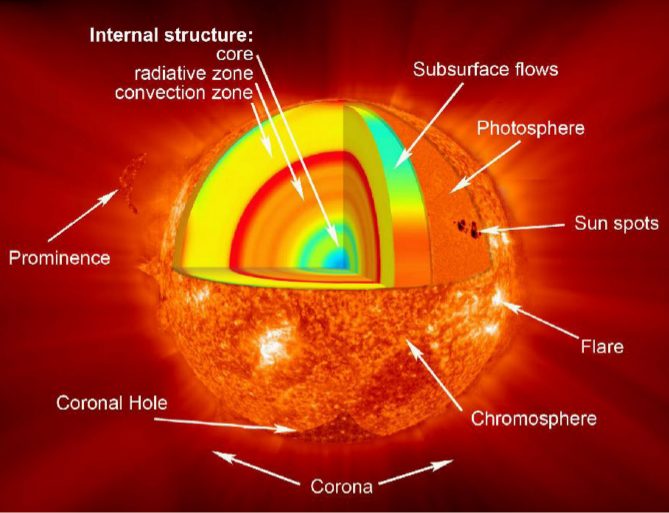The Sun, which binds all the planets of the solar system by its gravitational force, is a moderate-sized star. It is the nearest star from Earth and fulfills most of the requirements of light and heat needed to sustain life on our planet.
The Sun emits a steady stream of charged particles called the solar wind that passes by Earth and the other planets creating what is known as ‘space weather’, which affects the Earth in many ways. At its worst, it can even damage satellites and cause electrical blackouts on Earth! To understand more about it, let us know more about the Sun.
Physical properties of the Sun
The Sun is a star and does not have a solid structure. Rather it is a hot, gaseous body with a core temperature of around 15,000,000°C and a surface temperature of about 5,600°C.
Due to the extremely high temperature, no matter on Sun can exist in a solid or liquid state. It can exist only as plasma – a gas of ions. The mass of the Sun is estimated to be about 2×1030 kg, which is about 3,33,000 times the mass of Earth.
Hydrogen and helium are the most abundant elements found on the Sun, making up about 98 percent of its mass. The remaining amount is made up of oxygen, carbon, and other elements. The helium on the Sun was discovered in 1868, almost 27 years before it was found on Earth (1895). Helium on the Sun was detected with the help of a spectroscope from Guntur (Andhra Pradesh) during the Total Solar Eclipse on 18 August 1868. The Sun is not stationary but rotates around its axis once in about 27 days. Being a gaseous body, different parts of the Sun revolve at different speeds. Its rotation period at the equator is around 25 days, which goes up to about 38 days near the poles.
The internal structure of the Sun
The temperature at the central part of the Sun is exceptionally high. At this high temperature, the nuclei of hydrogen start turning into helium nuclei through a process called thermonuclear reaction, which releases tremendous amounts of energy. In the process, around 42.50 lakh tons of hydrogen is converted into helium per second. This process is mainly responsible for producing energy in the Sun or any other star.
The core of the Sun is surrounded by six concentric spherical layers called a radiative zone, convection zone, photosphere, chromosphere, transition region, and corona, respectively. From Earth, we can see only the outer layers, namely the photosphere, chromosphere, and corona. Sunlight comes mainly from the photosphere; the chromosphere and the solar corona are normally not visible. But during a total solar eclipse, when the Moon covers the photosphere, the chromosphere can be seen as a red rim around the Sun and the corona appears as a faint halo around the blackened Sun.
The temperature in the Sun does not vary regularly. As we move towards the surface of the Sun from the core, the temperature decreases from 15,000,000°C to 3,727°C in the chromosphere. Thereafter the temperature rises again and reaches up to 1,800,000°C in the corona. The region between the chromosphere and corona, where the temperature rises again, is called the transition zone. The reason for this sudden increase in temperature is still a subject of investigation. Some researchers believe that the photosphere heats the corona from the non-thermal source of energy stored in its magnetic fields. This may involve two mechanisms: one is the current generated by the changing magnetic field and the other is magnetohydrodynamic waves.
The Sun occasionally shows dark spots on its surface called sunspots. These spots are not really dark but appear dark because they are cooler than the surroundings. Regions of the Sun near high magnetic fields get cooler as compared to the other areas. Therefore, they appear dark against the bright background giving the appearance of a spot. Every eleven years, the sunspot activity reaches the maximum, and a large number of sunspots are noticed on the Sun’s surface. The magnetic field of the Sun and the nature of sunspots are not yet fully understood.
The hydrogen present in the Sun gets consumed every moment in the formation of helium. When the store of hydrogen gets exhausted, there will be no fusion, and the Sun will stop producing energy. At that stage, the Sun will start to swell, cool, and will expand to become a huge red giant. At that time, the size of the Sun will increase by about two and a half times that of today, engulfing planets up to Venus and
maybe even Earth. After that it will start shrinking again, turning atoms of helium into more massive atoms like carbon and oxygen. But with Sun’s mass, the process cannot go any further and a stage will come when all reactions will stop. The newly formed elements will collect at the center of the Sun, which will then shed most of its red giant envelope – creating a planetary nebula and leave behind a hot white dwarf star as a remnant. The Sun has existed for about five billion years and will last for another five billion years.
Space weather caused by the Sun
In addition to light and heat, the Sun gives out electromagnetic radiation of other wavelengths. These wavelengths include radio waves, ultraviolet rays, high energy X-rays, etc. The Sun also emits streams of charged particles commonly known as the solar wind. Explosive events like solar flares and coronal mass ejections (CMEs) cause a violent release of gas and magnetic fields at the Sun’s surface, which send solar storms into space. Some of the energetic particles of these storms are deflected by the Earth’s magnetosphere. When the energetic particles collide with the atoms in the Earth’s upper atmosphere, it creates a natural display of light called aurora. Auroras are the most visible effect of the Sun’s activity on Earth’s atmosphere. To observe space weather events, scientists use different instruments like land- and space-based sensors and imaging systems to view the activity at various depths in the solar atmosphere.
Observation of the Sun
Events like solar eclipse are very rare. They are natural phenomena that are well understood scientifically. Many important scientific observations related to the Sun can only be carried out during such occurrence. On normal days, many features and phenomena of the Sun cannot be studied due to the brilliance and high luminosity of the Sun. During a solar eclipse, when the Sun is covered by the Moon, the outer layers of the Sun become visible. It gives a window of opportunity to the scientists to study more about the Sun. Today, we know several important facts about the Sun but many phenomena like physical and dynamic processes inside the solar corona, the sharp increase in temperature in the corona region, the magnetic field of the Sun and sunspot, etc., are yet to be understood completely.
By: Rajat Manro











Usually, I never comment on blogs but your article is so convincing that I can’t stop myself to say something about it. You’re doing a great job Man, Keep it up. I cant wait to see your post soon. Good Luck with the upcoming update. This article is really very interesting and effective.